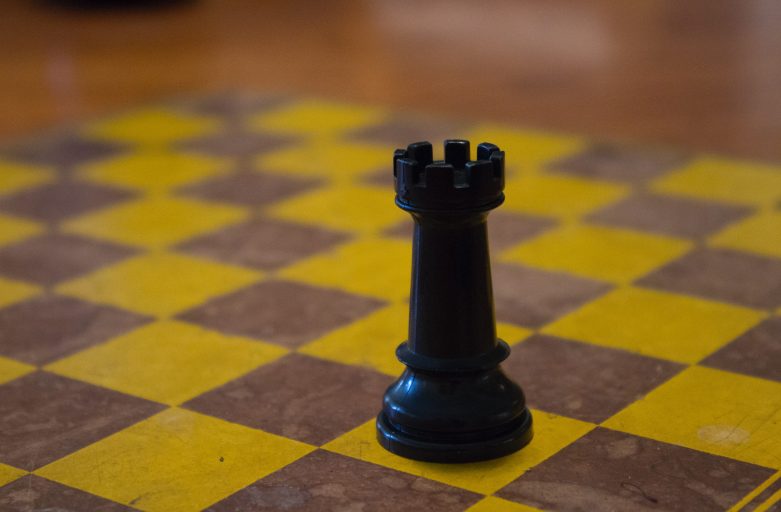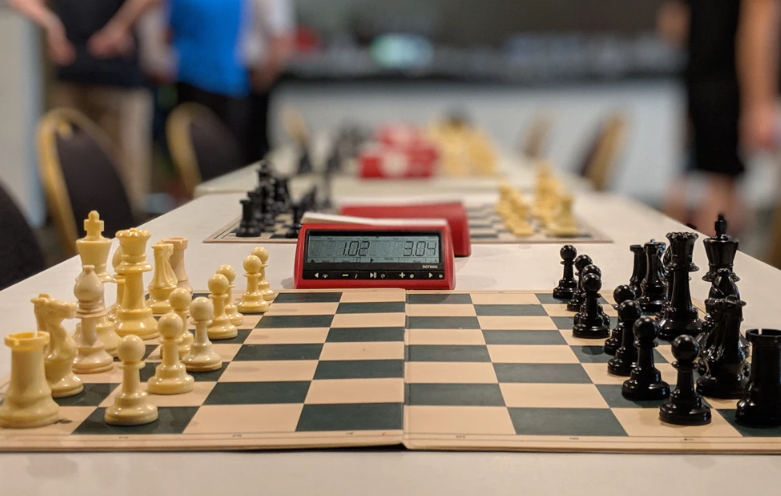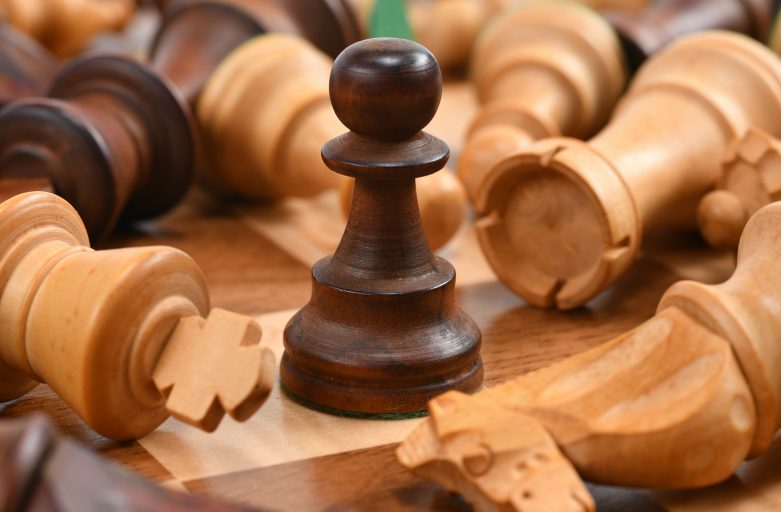This may seem massively elementary, but taking some time to better understand the chess board has merit.
The chess board is a simple 8×8 board with two alternating color complexes: light and dark.
Columns are called Files, Rows are called Ranks
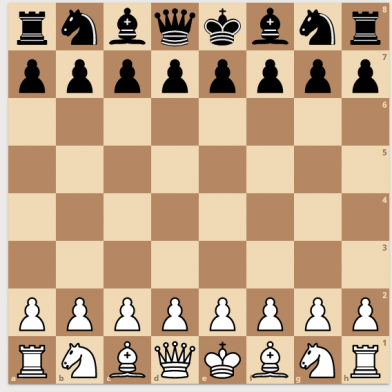
The files are identified with letters a-h and the ranks are numbered 1-8. In notation, files and ranks are absolute though, curiously, ranks are occasionally referred to in a relative sense when talking about generic strategy.
Examples:
The ‘a’ File is the leftmost column when you’re white and the rightmost column when you’re black
The 1st rank is the row that the white king starts on. The 8th rank is the row the black king starts on.
Occasionally when talking strategy, users will say something like “Get your rooks to the 7th rank!”. In this case, the rank is considered relative.
Tangent: Chess Notation!
Chess moves are recorded with a standard nomenclature using these identifiers:
King = K
Queen = Q
Bishop = B
Knight = N *ooooh phonetic
Pawn = none
So, Nf6 means white has moved their knight to f6
e4 means that white has moved their pawn to e4
If two pieces can move to the same location the notation prefaces the destination with the departure file like this: Nbd2 this would mean the knight on the b file is moving to d2.
Sometimes if the file of the pieces is the same they will use rank. And in rare cases where the board is whacko (extra promoted pieces everyhwere) they will use both.
Extra fun notation:
x means capture: Bxe4 (bishop is capturing the piece on e4)
0-0 means castling king-side
0-0-0 means castling queen-side
+ means check
# means checkmate
= pawn promotion, like this: e8=Q. This means the pawn moved to e8 and was promoted to Queen
In this manner a chess game can be written out like this:
- e4 e5
- Nf3 Nc6
- Bb5 a6
etc…
To derive the greatest understanding from board exploration, it helps to understand the value of the individual pieces. Let’s take a look:
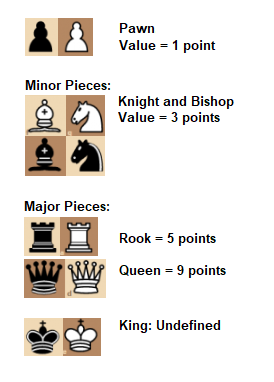
What does “value” mean? Value helps you understand typically how helpful a piece is on the board. Simply speaking if you had an option to exchange a rook for a bishop and a knight you could do some quick math: 3+3 > 5. So yeah, that’s a good deal go for it. But… it doesn’t always work perfectly because piece position matters. Think about it, if you have a pawn about to promote to queen it’s definitely worth more than 1 point. We’ll save in depth positional analysis for the future, but now we can head back to the board itself to see how position affects value in a broad sense.
Sometimes people describe the board as a pyramid where the strongest squares are in the middle with power waning as you move to the edges. This is true for the most part. Think about it geometrically. A bishop in one of the center four squares can move to 13 other squares. A bishop on the edge can only move to 7 squares. The same is even more true for a knight. A knight in the center covers 8 squares. A knight in the corner? Only 2. The power of a piece has a lot to do with its position and the resulting influence it carries over the rest of the board.
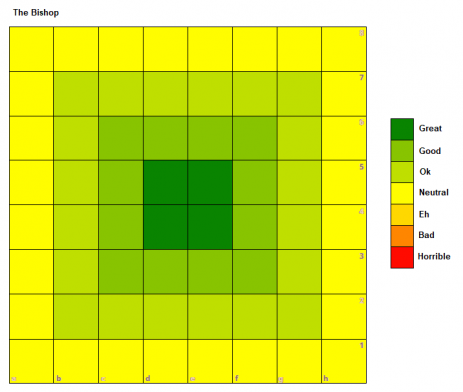
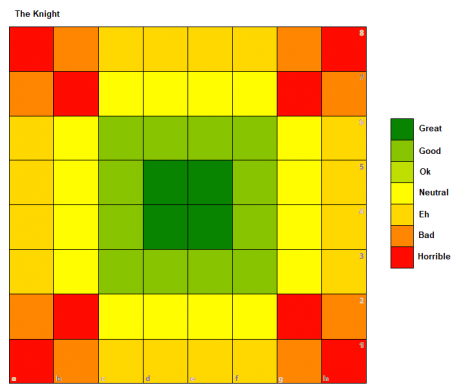
NOTE: the b2, b7, f2 & f7 squares I rate as “horrible” even though they have a slightly higher positional value compared to their outward neighbors because of specific disadvantages of the square as described in Jesus de la Villa’s 100 Endgames You Must Know
This is where we come up with the general rule of thumb: fight for the center. If you can navigate more of your pieces into the center they will be more effective and have more offensive/defensive capabilities.
Fun fact – another rule of thumb that relates to this: A knight on the rim is dim
Understanding the board and the value of the pieces helps us understand how to move our pieces. It is my understanding that this is how chess computers calculate the best move. They evaluate positions, rate them on a scale, and then calculate which moves improve the evaluation. Most simple chess engines rate a position down to the centipawn – that is, 1/100th of a pawn i.e. Position A is 36 centipawns better than Position B. CRAZY!
There are a few other unique facets of the bishop and knight beyond what we’ve already discussed. Let’s take a look
Knight
- Since Knight’s can jump, they tend to do better when the board is congested and locked up with pawns everywhere with no room for other pieces to move around. The Knight’s value increases when the board is cramped. There are specific pawn structures which we’ll look at later that are considered “closed” or “open”. Knights do best in closed cramped positions.
Bishop
- Because each bishop is confined to a single color complex, they work better together. For this reason if one of your bishop’s has been captured you may be at risk for a weakness that covers one color complex. For example if you lose your light squared bishop early in the game your opponent can place their pieces on light squares and have virtual immunity from your remaining dark square bishop
- Bishops can be easily stifled when other pieces (pawns in particular) get in their way. For this reason they operate in an opposite manner to knights: they do best in open uncramped positions
- Put those two together? As the game approaches its end, having the bishop pair in an open position is SUPER POWERFUL. I’m not sure if it’s still true, but some computers used to rate bishops as 3.4 points each at the start of the game for this reason. In some end games, a bishop pair can be so brutally oppressive that they carry more useful value than the rooks
We’ve spent a lot of time on the knight and bishop. What are the positional advantages of the other pieces? Here are a few more generalities:
Rooks
- Rooks are most valuable on open files, that is: files that don’t have any pawns on them. This means they tend to get more power and utility as the game progresses.
- Rooks are more valuable when they are connected (protecting each other) than when they are lone rogues
- Rooks tend to be powerhouses of destruction if they can both get to the 7th rank (relative)
Pawns
- Pawns are more valuable on the center files than the fringe files. The pawn in front of your queen is more likely to play an active role in the game than the pawn in front of your rook. This is where another rule of thumb arises: When you have the choice of which pawn to use when capturing an enemy pawn, capture TOWARDS the center.
- Pawns like to be near their friends. An isolated pawn (one that has no peers on the adjacent files) was long seen as a weakness, though I believe there’s some counter theory these days. Connected pawns, those that are protected by their peers, are much stronger. A string of connected pawns is called a pawn chain.
- A backwards pawn (I hate that name) is the last pawn in a pawn chain, the anchor so to speak, and is often a target of attack. I’m not sure if there’s much to be said about value here, just a hint to protect your backwards pawns and target your opponent’s backwards pawns
- A passed pawn is a pawn that can no longer be blocked or attacked by an opposing pawn (no opposing pawn in front of it, or in either adjacent file). A passed pawn is like an infection in your opponent’s wound. It will grow in power and impose graver and graver risk to your opponent as it gets closer to promotion on the 8th rank.
- Stacked pawns are two pawns on the same file. This occurs when one pawn moves diagonally in front of, or behind, its peer to capture a piece. Stacked pawns are generally seen as a weakness, though as with any generalization: it depends.
Queen
- Queens are powerful but fragile. They have the most influence in the center, but they are too delicate to get out early. Keep them back in the early part of the game and bring out their fury as you enter the middle game
King
- Kings are best tucked away in a corner via castling early in the game. But by the end of the game (once some/all of the major/minor pieces have been captured), get them active and get them to the center. A game can easily be won or lost with an active king in the endgame.
Where does all this lead us? The combination of the board, piece motion, and piece value provides a nice foundation for strategy. It provides a simple introduction on what’s a good piece vs a bad piece and how to tell the difference. Hopefully you’ve found it interesting. If you have any articles or books you’d recommend related to this topic, I welcome you to comment. Enjoy your games!
